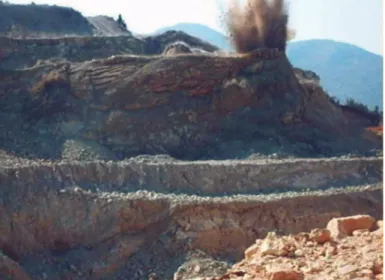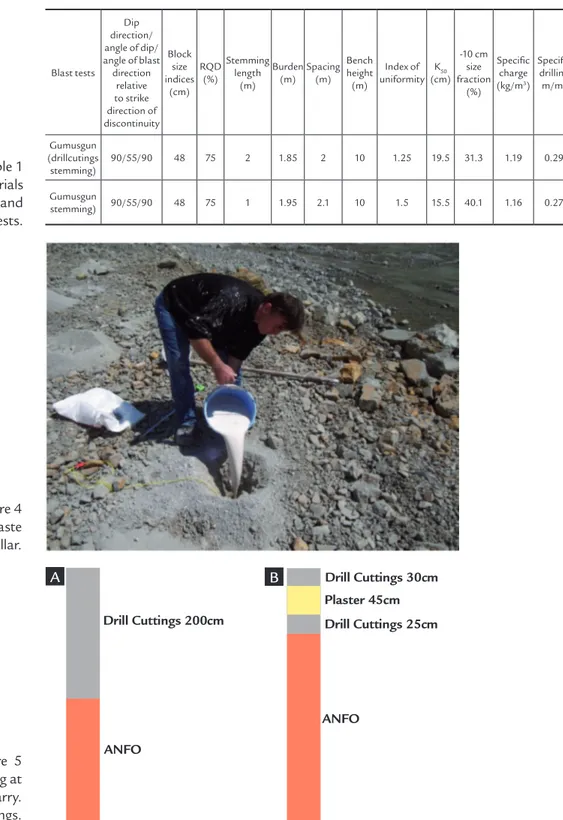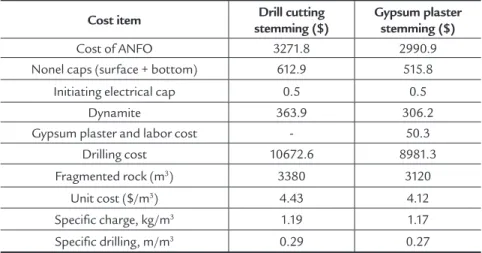Resumo
Aparas e pó de perfuração são, geralmente, utilizados em pedreiras e minas a céu aberto, como o material de tamponamento mais comum, uma vez que são mais facilmente disponíveis nas frentes de desmonte. O tamponamento com gesso mostrou-se de melhor uso do que o com detritos de perfuração, devido ao aumento do coninamento dentro dos furos e melhor utilização da energia explosiva no desmonte do maciço. A principal vantagem do novo método é a redução do custo do desmonte. Em uma pedreira de calcário, os custos de detonação por unidade de volume de rocha desmontada foram reduzidos em 7%. Isto foi obtido através do aumento da carga e distâncias de espaçamento. Além disso, a melhor fragmentação foi obtida, usando-se o método de tamponamento com gesso. Ensaios de detonação mostraram que o uso do gesso produziu material mais ino do que os métodos convencionais. Em ensaios sob mesmas condições, a geração de matacões acima de 20 cm de tamanho foi de 42,6% do total, comparado com 48,7% no método convencional, usando-se espaçadores e tamponamento de aparas de perfuração.
Palavras-chave: Tamponamento com gesso, tamponamento, detonação, fragmentação, calcário.
Abstract
Drill cuttings are generally used in open pits and quarries as the most common stemming material, since these are most readily available at blast sites. The plaster stemming method has been found to be better than the drill cuttings stemming method, due to increased coninement inside the hole and better utilization of blast explosive energy in the rock. The main advantage of the new stemming method is the reduction in the cost of blasting. At a limestone quarry, blasting costs per unit volume of rock were reduced by 7%. This is obtained by increasing burden and spacing distances. In addition, better fragmentation was obtained by using the plaster stemming method. Blast trials showed that plaster stemming produced iner material than the conventional methods. In the same blast tests, +20 cm size fragments reduced to 42.6% of the total, compared to 48.7% in the conventional method of drill cuttings stemming.
Keywords: Plaster stemming, stemming, blasting, fragmentation, limestone.
Halim Cevizci
Suleyman Demirel University. Mining Engineering Department. Isparta, Turkey.
halimcevizci@sdu.edu.tr
A new stemming application
for blasting: a case study
Uma nova aplicação para tamponamento no
processo de detonação: um estudo de caso
eficient stemming with better coninement increases the generation of ines. Also, better rock breakage can be obtained. On the other hand, there is an increased scat-ter distance, giving rise to a looser muck pile that can be more easily loaded and transported (Ozkahraman, 2006).
Blasting results showed that coarse angular crushed rock is better than ine drill cuttings for stemming (Tamrock, 1984). Dobrilovi´c et al. (2005) studied stemming material consisting of broken limestone and found that the +16–32 mm fraction was the best-suited material. In this study, a new stemming material was investigated with the aim of increasing the blast energy directed to the rock. For this purpose, quick-setting molding plaster was used as a stemming material. Apart from the work of Cevizci (2012), there is no previous work found in the literature citing the usage of this material. Blasting tests were carried out in quarries by using both the suggested new stemming method and classical stemming material, and per-formance measurements carried out by image analysis of fragmented rock piles.
Drill cuttings are the most common stemming material used in open pits and quarries, since they are most readily avail-able at blast sites and are cheap. However, dry drill cuttings eject very easily from blastholes without offering much
resis-changing the blasting parameters of open pit blasts and obtained better results with the plaster stemming method in two differ-ent limestone quarries and one clay quarry. These blasting trials were carried out on the same benchmarks and under same rock conditions. The new method employs a plaster prepared as a thick paste, which hardens in less than 25-30 minutes after application. The hardened plaster creates a very strong plug, therefore the stemming column length can be reduced and the explosive column length increased. This increased explosive column results in better rock breakage than similar holes stemmed with dry drill cuttings. Also, this increased utilization of the hole’s length reduces speciic drilling costs due to increased burden and spacing distances. Blasthole drilling constitutes a major cost in blasting operations. Another advantage of the new method is better fragmentation, with more induced cracking in the rock mass.
In one series of blast tests, blast-ing costs per unit volume of rock were reduced to 16% by increasing burden and spacing distances (Cevizci, 2012). Also, better fragmentation was obtained by using the plaster stemming method. Blast trials showed that plaster stemming produced iner material. In the same blast tests, +30cm size fragments reduced to 5.4% of the total, compared to 37.7% in
known to be a function of site conditions (i.e. geological conditions) and scaled dis-tance, SD = D/W1/2, for surface blasting;
where D is the distance from the blast face to the vibration monitoring point and W is weight of explosive per delay (Devine et al., 1966).
At the study (Cevizci, 2012) using the plaster stemming method, 61.3 kg explosive per delay was used compared to 58.7 kg in the drill cuttings stemming. This increase in explosive charge caused an increase in PPV value from 12.0mm/s to 17.8 mm/s, whereas it should cause only a 0.4 mm/s increase in PPV value according to calculation from the theo-retical formula. The vibration and air shock values measured at the Bozanonu limestone quarry test trials with both the drill cuttings stemming and the plaster stemming were under the safety limits speciied in the limit criterion. At the top-level bench, small quantities of ly rock were generated, but this did not constitute a major problem. In addition, the plaster stemming round resulted in a slightly more scattered muck pile owing to more blast energy directed to the rock, but this did not create a big problem either. Loading of the muck pile was easier due to the looser particles.
Also at another limestone quarry, a blasting test with plaster stemming was
Figure 2
A plaster plug is not ejected from the hole during explosion at a basalt quarry.
performed and measurements were taken at 39 m in the locations where vibration and air shock occurred, as shown in Fig-ure 3 (Cevizci & Akcakoca, 2011).
At Bastas limestone quarry, 25 cm of drill cuttings were placed between the
explosive and the plaster paste (Cevizci, 2012). Length of plaster column was 45 cm. The top 55 cm of the drill hole was illed with drill cuttings. With a plaster stemming round, total length of stem-ming was 1.25m and no ly rock was
generated at the top level bench, similar to the drill cuttings stemming round test trial. Also, the scattering of the muck pile with the plaster stemming round was similar to scattering of the drill cuttings stemming round.
Figure 3
cuttings were used as stemming material at different lengths in similar blastholes on the same quarry bench. A thick milky
in contact with ANFO, which is water-sensitive, thus 25cm of drill cuttings were placed between the explosive and
leaving it empty. This had the advantage of protecting the hole from loose stones dropping in.
Figure 4 Pouring of plaster paste into hole collar.
Figure 5 Blast hole Stemming at Gumusgun limestone quarry. (A) Stemming with drill cuttings. (B) Stemming with plaster. Table 1 Summary of properties of materials
at blast site, blast patterns and measurements of blast tests.
Blast tests Dip direction/ angle of dip/ angle of blast direction
relative to strike direction of discontinuity
Block size indices
(cm) RQD
(%)
Stemming length
(m) Burden
(m) Spacing
(m) Bench height (m)
Index of uniformity
K50 (cm)
-10 cm size fraction
(%)
Speciic charge (kg/m3)
Speciic drilling m/m3
Gumusgun (drillcutings stemming)
90/55/90 48 75 2 1.85 2 10 1.25 19.5 31.3 1.19 0.29
Gumusgun
stemming) 90/55/90 48 75 1 1.95 2.1 10 1.5 15.5 40.1 1.16 0.27
A B
Drill Cuttings 200cm
ANFO
ANFO
Drill Cuttings 30cm
Plaster 45cm
Figure 6
Cracked hole collar and hardened plaster
3. Blast trials and results at Gumusgun limestone quarry
Two test blasts were carried out at Gumusgun limestone quarry. The irst round was carried out by using drill cut-tings stemming. The second round was carried out by plaster stemming. In both two rounds, all of the 89 mm diameter holes were drilled with Tamrock drillers. Compared to blasting with drill cuttings stemming, burden and spacing distances were approximately 4% larger at plaster stemming method. Nobelex 100G dyna-mite was used as primer at the bottom
of holes. Only one primer initiated with Nonel cap in each hole, which was con-sidered enough for detonation. Extra 625 g of dynamite was also used without cap in the middle of ANFO column. The iring was started with one electric cap. At the surface 42ms and at the hole bottom 500ms Nonel millisecond caps were used.
Drill cutting stemming method is globally used in open pits and quarries. Therefore the stemming blast holes with
drill cuttings procedure is a standard procedure and details of this procedure is not given in the paper; instead the new and more eficient plaster stemming is more emphasized. For comparison of two stem-ming procedures, test blasts were carried out in the same location. Therefore, the rock structure and strength were simi-lar. In both rounds ANFO, with double primer containing of 625g dynamite was used. A quick hardening molding plaster was used for plaster stemming.
The evaluation of blast trials
The blasting results of two stem-ming methods were compared. Muck pile fragmentation was evaluated using Split Desktop image-analysis software and veriied standard ‘‘compare photo’’ method. The rock piles from the blast-ing tests at Gumusgun limestone quarry are shown in Figure 7 and Figure 8. The cumulative percentage of retained size at the Gumusgun limestone quarry blasting tests is given in Table 2.
The irst round was carried out us-ing drill cuttus-ings stemmus-ing with 92 holes.
The length of the stemming was 2 m. The second round was carried out by plaster stemming with 77 holes. The length of the stemming was 1 m. Each blasthole was illed with 42.6 kg ANFO initiated with one primer with 0.625 kg in weight in the case of the drill cuttings stemming method. For the plaster stemming method, the quantity of ANFO was 46.3 kg per blasthole. The total length of ANFO col-umn in the plaster stemming method was 100 cm greater than for the conventional method of drill cuttings stemming.
The blasted area was 338 m2 for
the drill cuttings stemming trial, and blasted volume was 3380 m3 in situ. The
speciic charge was found to be 1.19 kg/ m3 and the speciic drilling was 0.29 m/
m3. The blasted area was 312 m2 for the
plaster stemming blast trial and yielding the blasted volume was 3120 m3 in situ.
The speciic charge was 1.17 kg/m3 and the
speciic drilling was 0.27 m/m3.
The total length of holes for the plas-ter stemming trial at Bozanonu limestone quarry was 76.4 m less than for the drill
Figure 7
Table 2 Comparison of cumulative percentage
of retained size (oversize) from blast trials with plaster stemming and drill cuttings stemming.
Fragment size
(cm) Gumusgun drill cutting stemming (%) Gumusgun plaster stemming (%)
100 0.0 0.0
70 1.8 1.9
50 8.9 6.7
40 17.2 15.6
30 31.3 27.8
20 48.7 42.6
15 59.2 50.4
10 69.9 60.8
5 82.4 72.5
Table 3 Comparison of cost of blasting
of plaster stemming with drill cutting stemming.
Figure 8 Rock pile from blast round with plaster stemming at Gumusgun limestone quarry.
cuttings stemming round. This resulted in 9% less drilling per unit volume rock. The cost saving for drilling calculated was $825.5 (76.4 m x10.8 $/m). At this site, speciic drilling and speciic charge decreased because a larger burden and spacing were applied with the plaster stemming method. In order to fragment
the same volume of rock as for the plas-ter stemming round, an additional hole length of 76.4 m should be drilled for the drill cuttings stemming round. The proit per unit volume was $0.31 and total proit by using plaster stemming was $967.2 (Table 3).Therefore, the plaster stemming trial was found to be
more economic, as well as giving better fragmentation. For instance, the +20 cm size fraction dropped from 48.7% to 42.6%. Therefore, better fragmenta-tion is obtained with $967.2 proit. Also, the amount of -10 cm size material was increased from30.1% to 39.2%. This has beneits in crushing and grinding.
Cost item Drill cutting
stemming ($)
Gypsum plaster stemming ($)
Cost of ANFO 3271.8 2990.9 Nonel caps (surface + bottom) 612.9 515.8
Initiating electrical cap 0.5 0.5
Dynamite 363.9 306.2
Gypsum plaster and labor cost - 50.3 Drilling cost 10672.6 8981.3
Fragmented rock (m3) 3380 3120
Unit cost ($/m3) 4.43 4.12 Speciic charge, kg/m3 1.19 1.17
Speciic drilling, m/m3 0.29 0.27
4. Conclusion
In the method presented in this study, the ineficiency of the drill cuttings method of stemming is overcome by using plaster stemming. With the old method of stemming, loosely placed drill cuttings do not effectively conine the high-pressure stress produced by blasting. The study
clearly shows how gases escaping from the drill hole, without eficient coninement, waste blasting energy. With the plaster stemming method, the pressure of the ex-plosive is used successfully due to the more eficient coninement of the blast because better fragmentation was obtained.
5. Acknowledgement
Author thank to HuseyinYavuz and Lütfullah Gündüz for theirs encourage- ment and help.
6. References
BOSHOFF, D., WEBBER-YOUNGMAN, R.C.W. Testing stemming performance, possible or not?. The J. of The South African Inst. of Min. and Metall., p. 871-874, December, 2011.
CEVIZCI H., ÖZKAHRAMAN, H.T. The effect of plaster stemming to blast fragmentation at clay quarrıes. In: WORLD MINIG CONGRESS & EXPO, WMC-2011, 22. Istanbul, Turkey. v. 1, p. 551-554, 2011.
CEVIZCI, H. A newly developed plaster stemming method for blasting. The J. of The South African Inst. of Min. and Metall., December. p. 1071- 1078, 2012.
CEVIZCI, H., ÖZKAHRAMAN, H.T. The effect of blast hole stemming length to rockpile fragmentation at limestone quarries. International Journal of Rock Mechanics and Mining Sciences, v. 53, p. 32-35, 2012.
DOBRILOVIC, M., ESTER, Z., JANKOVIC, B. Measurement in blast hole stem and inluence of stemming material on blasting quality. In: Rudarsko-geološko-naftnizbornik v.17, Zagreb. p. 47-53, 2005.
KUZU, C. The importance of site-speciic characters in prediction models for blast-induced ground vibrations. Soil Dynamics and Earthquake Engineering, v. 28, p. 405-414, 2008.
OZKAHRAMAN, H.T. Fragmentation assessment and design of blast pattern at Goltas limestone quarry, Turkey. International Journal of Rock Mechanics& Mining Sciences 43, p.628-633. 2006.
TAMROCK. Handbook on surface drilling and blasting. Painofaktorit, Finland, 1984. 310 p.
2012). This region, called the hard cap rock region, is not effectively broken with the classic drill cuttings stemming method. Generally, as the stemming col-umn increases in length, more boulders are produced, which are dangerous and costly to move.
Additionally, the new method of-fers a more proitable solution. The cost of drilling for one meter of hole length is almost $10.8. With plaster stemming, more of the hole length is better utilized
by increasing the loaded length of the hole, resulting in better breakage at the hole collar. The increased length of loading in the hard cap rock region improves the cap rock breakage, thus reducing the creation of oversized boulders and increasing both eficiency and proit. It was observed that a plaster stemming column 0.45 m in length provided a more robust sealing than 2m of drill cuttings used in the classical method. Carrying out the plaster stemming in the ield does not take a lot of time and
is not dificult or expensive. At present, hand loading is used. We are developing a machine for preparing the plaster solution that incorporates a charging unit.
Recently, this stemming method has found acceptance by some quarries. It was reported from these quarries that the new method meets their needs for aggregate production with minimum cost.
However, plaster stemming method cannot be used in a quarry where holes are illed with water, as in the case of ANFO.


